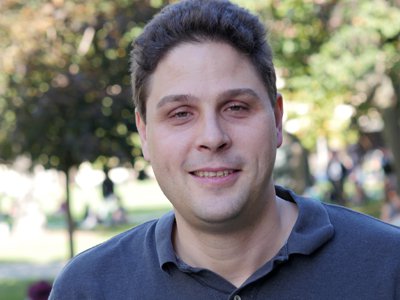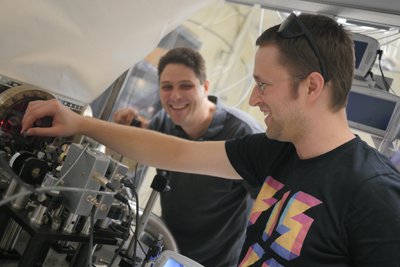Measuring the Elusive ‘Big G’
Syracuse physicist part of $600,000 grant to more accurately measure gravity

Stefan Ballmer, associate professor of physics in the College of Arts and Sciences, and collaborators from two other universities received a three-year, $600,000 National Science Foundation grant, $120,000 of which is coming to Syracuse. The grant aims to nail down the highly important, but imprecisely known gravitational constant. By building a carefully designed pendulum, Ballmer and collaborators hope to reduce the uncertainty in measurements of gravity, or “big G.” Under-represented Hispanic and Latino students will also participate in the efforts to improve our understanding of the universe.
“Uncertainty in the knowledge of G puzzles the fundamental physics and precision measurement communities,” Ballmer says. “The world's best experiments yield values which differ by about 40 times the uncertainty of the most precise experiments.”
Big G, so called to distinguish it from Earth’s local gravitational effects of “little g,” is commonly used in astrophysics, including in calculating a rocket’s escape velocity. Big G also is needed to reconcile Albert Einstein’s theories of general relativity and quantum mechanics.
For all of big G’s importance, physicists have struggled to get a precise measurement for centuries. Ballmer and collaborators Ricardo Decca, professor of physics at Indiana University, and C.D. Hoyle, professor of physics and astronomy at Humboldt State University, are turning to an approach similar to the very first measurement of big G.

Like Henry Cavendish, the first physicist to measure big G in 1798, Ballmer and colleagues will construct a rotating pendulum, known as a torsion pendulum. Unlike the swinging pendulums commonly encountered at museums, the torsion variety’s restoring force comes from a twisting suspension fiber, rather than swinging due to gravity. Ballmer and collaborators will hang the pendulum from a central turntable surrounded by a second turntable with precisely made crystalline silicon cylinders. As the turntables rotate, the cylinders exert a measurable gravitational force on the pendulum.
The pendulum will be built at Indiana University; Syracuse will supply the metrology system. Similar to other modern apparatuses, this pendulum’s string will be kept straight, which avoids the systematic uncertainties caused by fiber twisting. By using a computer-controlled pendulum turntable, the fiber never twists; rather the pendulum is kept “freely falling” for hours, Ballmer explains.
Using the torsion pendulum the researchers will take three separate measurements of G.
“If we add one more measurement to previous data points that all disagree, we really won’t learn much,” Ballmer says. “But if we can demonstrate that methods of previous experiments agree with our measurements, or we understand why they disagree, we’ll learn something.”
Partnering with Humboldt State University, a rural, federally recognized Hispanic Serving Institution, demonstrates the Syracuse gravitational wave group’s history of involving under-represented young scholars in astrophysics research. Indeed, the group has an NSF-supported partnership with California State University Fullerton to increase Hispanic and Latino participation in astronomy and physics. Adding the Humboldt State University partnership showcases the group’s continued commitment to diverse voices in academic research.
